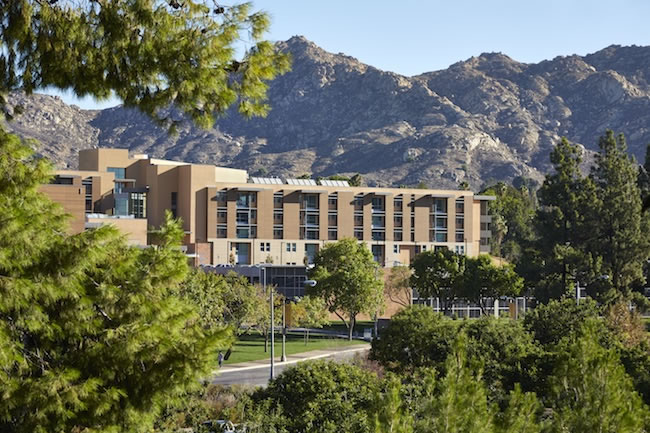Glen Mor 2, an 800-bed student apartment complex on the University of California, Riverside campus, stands out among student housing projects not only with regard to sustainability, but also for integrated planning, landscape restoration, independent campus living, and marketability.
Designed by Watertown, Massachusetts-based Sasaki Associates, the LEED Gold-seeking project champions sustainability, creates a green amenity from an eyesore, links disparate areas of the campus community, blurs the border between campus facilities and the community at large, and improves pedestrian circulation.
The four-bedroom design is aimed at retaining upper-division students and attracting transfer students who desire an independent living arrangement, combined with dynamic residential life programs, dining opportunities, academic support, and campus proximity. Completed in 2014, the project’s five, five-story buildings are now 100% occupied.
BELATED CONSTRUCTION
PROJECT
Location Riverside, CA
Client University of California, Riverside
Size 343,000 ft 2 (plus 202,000 ft 2 parking structure)
Completion July 2014 Certification LEED Gold- seeking
Cost $115 million
SUPPLIERS
Windows Peerless
Curtain Wall & Storefront Arcadia
Cabinets Stolo Cabinets, Pionite, Formica
Counters Corian, Avonite, Ceasarstone, Trend Q Doors Arcadia, Timely, Lynden Door
Glass Oldcastle, Skyline Design
Exterior Materials Sto, Cement Board Fabricators, Pacific Clay Products, Inc. Integrated Aluminum Sun Shades Arcadia Insulation Owens Corning, Thermafiber, Johns Manville
Delayed due to the economic downturn of 2008, this is one project that actually benefitted from the Great Recession, suggests Tim Stevens, AIA, LEED AP, a former Sasaki principal now with the San Francisco office of Solomon Cordwell Buenz, noting that the lapse in time between its conception and start of construction removed the biggest challenge to sustainability. Initially university administrators weren’t exactly onboard for a sustainable project, he explains, but by the time the project was bid in 2011, “there was a lot of maturation to this ideal at the university [administrative] level.” With the transition in attitude, administrators had developed an understanding of the benefits of sustainability and a willingness to fund the extra costs, says Sasaki Principal Fiske Crowell, FAIA, LEED AP. He points out that the highest initial cost item was a solar domestic hot water system, which offsets approximately 45% of natural gas demand while addressing one of the highest residential energy use targets—hot water for showers.
A TUNABLE FAÇADE THAT OVERCOMES CLIMATIC CONDITIONS
To achieve LEED Gold criteria for building performance, the team had to address the region’s most pervasive environmental influences: an arid climate and intense sun exposure. Their innovative approach to this challenge is one aspect that truly makes this project unique. The passive design strategy includes a “tunable façade” created with a modular bathroom and kitchen core, set against multi-layered exterior walls. This flexible arrangement allows mass areas void of windows—closets and kitchens—to be tuned, or oriented—based on solar exposure. “This is an important strategy to get heat gain handled,” Stevens stresses, pointing out that with no windows facing south there is 100% horizontal shade on the glazing layer, and windows facing north capture more natural light. The project’s most exposed building façades also feature a ventilated barrier wall assembly, created with furring channels between the primary wall assembly and fiber cement board cladding to form a ventilated air cavity that dissipates solar heat gain, equalizes air pressures, and vaporizes moisture. This ventilation structure, along with shading, low-e glass, and optimized wall and roof insulation, contributes to a higher-performing building envelope.

The design combines calibrated overhangs and vertical shading fins, so when units are stacked, windows have optimal passive solar response.
PASSIVE DESIGN THAT REFLECTS AESTHETIC CHARACTER
“The tunable façade becomes an aesthetic character of the project and sets it apart from other student housing projects,” Stevens continues, noting that the design combined calibrated overhangs and vertical shading fins, so when units are stacked, windows have optimal passive solar response. Using this innovative approach resulted in individual expression of building façades based on their orientation that enhanced the character of the living environment, as well as building energy performance. The combination of a passive design, high-performance materials and the solar thermal mechanical system boosted energy performance 48% above California’s 2014 Title 24 energy mandate. Title 24 requires all buildings to reduce energy consumption 25% below 2008 levels.
CREATIVE PLANNING FOR VISUAL INTEREST
Building setbacks were used to retain a mature, lush, oasis-like landscape on the southern edge of the site, which creates a transition between the adjacent residential neighborhood and campus facilities and blurs the campus border with the community at large. The eastern border is the site’s most distinct landscape with a ridge that gradually rises from the west and follows the arroyo. The design team capitalized on the topography, stepping Glen Mor 2 structures up the hill with a series of terraces to create a buffer to the east that conceals the parking structure and softens the effect of apartment buildings in neighboring communities and provides sweeping views of the campus and arroyo from upper terrace structures.
NEGLECTED ARROYO TO COMMUNITY AMENITY
An overgrown natural arroyo, which serves as a drainage channel for the campus, was reclaimed as open space on the northern edge of the site. An in- digenous landscape transformed it to a sustainable greenway with pedestrian pathways alongside that connect disparate areas of the campus community and improve student mobility. Two pedestrian bridges across the arroyo join Glen Mor 1—a, 500- bed student apartment complex also designed by Sasaki—with Glen Mor 2 to create a unified community that shares communal and lifestyle amenities, including fitness facilities, a pool, and multipurpose rooms and gathering places for hosting social activities.

With no windows facing south, there is 100% horizontal shade on the glazing layer, and windows facing north capture more natural light. The outboard bedroom closets at the upper levels of student housing act as vertical shading fins on the bedroom windows.

